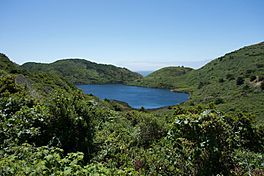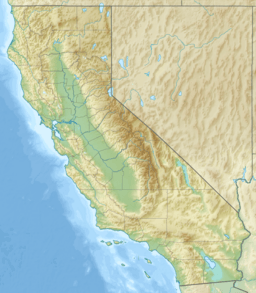Pelican Lake (Marin County, California) facts for kids
Quick facts for kids Pelican Lake |
|
|---|---|

Pelican Lake seen from the Palomarin Trail near Alamere Falls.
|
|
| Location | Marin County, California |
| Coordinates | 37°57′01″N 122°46′31″W / 37.95028°N 122.77528°W |
| Type | slightly saline slightly alkaline slightly eutrophic warm monomictic |
| Primary outflows | via Pelican Lake Creek to Pacific Ocean |
| Basin countries | United States |
| Average depth | 30 feet (9 m) in July 1969 |
| Surface elevation | 203 feet (62 m) |
Pelican Lake is a small, pretty lake located in the southern part of the Point Reyes National Seashore. This special area is found northwest of a town called Bolinas in California. The lake sits about 203 feet (62 m) above sea level. Its water flows out through a short stream called Pelican Lake Creek. This creek travels southwest through a gap in the coastal cliffs. It then reaches Bolsa Beach at Double Point and flows into the Pacific Ocean.
Pelican Lake is one of five cool lakes in this area. These lakes are often called the Coast Trail Lakes. The others are Bass Lake, Crystal Lake, Ocean Lake, and Wildcat Lake. If you travel about 0.5 miles (0.8 km) northwest from Pelican Lake, you can find the amazing Alamere Falls. This waterfall flows right onto the beach!
Contents
How Pelican Lake Was Formed
Pelican Lake, like other lakes nearby, was created by natural events. It sits in a bowl-shaped dip in the land. This dip formed because of huge landslides that happened less than 10,000 years ago. These landslides moved large blocks of rock.
The Double Point Slide
The dips that hold Crystal Lake, Pelican Lake, and Bass Lake were likely formed by a massive event called the Double Point Slide. This landslide covered a huge area, about 1.7 square miles (4.4 km2). The rocks involved in this slide include shale, chert, and sandstone. Some of these rocks are similar to those from the Miocene period, which was millions of years ago. Others are like rocks from the Pliocene period.
Ongoing Landslides
The process that causes these landslides is still happening today. For example, some nearby slides were caused by the big 1906 San Francisco earthquake. Other slides have happened more recently, even as late as 1956. This shows that the land here is always slowly changing.
Plants and Animals Around Pelican Lake
Pelican Lake is part of the Southern Inverness Ridge area within the Point Reyes National Seashore. This region has a mix of coastal scrub and open grasslands. It's a great place to see many different kinds of plants and animals.
Coastal Plants
In this coastal area, you can find open groups of coyote brush (Baccharis pilularis). Often, native grasses like California oatgrass (Danthonia californica) and purple needlegrass (Nassella pulchra) grow among them. Other common plants in this ecosystem include California sage brush (Artemisia californica), black sage (Salvia mellifera), sticky monkeyflower (Mimulus guttatus), and poison oak (Toxicodendron diversilobum). You might also see California coffeeberry (Frangula californica) and tree lupine (Lupinus arboreus).
Plants Near the Water
Around Pelican Lake and the other nearby lakes, you'll find thick groups of willow trees (Salix species). Right at the edges of the lake, plants like common tule (Schoenoplectus acutus), California bulrush (Schoenoplectus californicus), cat-tail (Typha latifolia), and different kinds of sedges (Carex species) grow tall.
Fish in the Lake
Pelican Lake has been stocked with warm-water game fish. This means that certain types of fish that people like to catch for sport have been put into the lake.
Forests Above the Lakes
On the slopes above the coastal lakes, you can see stands of tall Douglas fir trees (Pseudotsuga menziesii). These trees add to the beautiful scenery of the area.
Wildlife Protection
Pelican Lake is very close to the Double Point Area of Special Biological Significance. This special area covers about 86-acre (35 ha). It was created in 1974 to protect a large group of harbor seals (Phoca vitulina). These seals raise their pups on the beach between April and June each year. It's an important place for them to have their babies safely.



